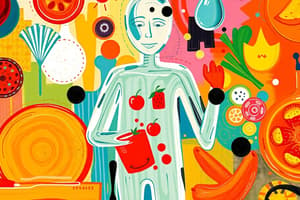Podcast
Questions and Answers
How can food handlers contaminate food? (Select all that apply)
How can food handlers contaminate food? (Select all that apply)
- When they have a foodborne illness (correct)
- When they have symptoms such as diarrhea, vomiting, or jaundice (correct)
- When they have contact with a person who is ill (correct)
- By sneezing or coughing (correct)
- By touching anything that may contaminate their hands and then they don't wash them (correct)
- When they have wounds that contain a pathogen (correct)
What is a carrier?
What is a carrier?
Someone who carries pathogens and infects others without ever getting sick themselves.
What are actions that can contaminate food? (Select all that apply)
What are actions that can contaminate food? (Select all that apply)
- Running fingers through the hair (correct)
- Wearing a dirty uniform (correct)
- Touching a pimple or an infected wound (correct)
- Coughing or sneezing into the hand (correct)
- Wiping or touching the nose (correct)
- Scratching the scalp (correct)
You must create and support policies that address what areas? (Select all that apply)
You must create and support policies that address what areas? (Select all that apply)
Where should you wash your hands?
Where should you wash your hands?
How should you wash your hands?
How should you wash your hands?
How long should the whole process of washing your hands take?
How long should the whole process of washing your hands take?
How can a paper towel aid you after washing your hands?
How can a paper towel aid you after washing your hands?
When should you wash your hands? (Select all that apply)
When should you wash your hands? (Select all that apply)
What is a hand antiseptic?
What is a hand antiseptic?
If hand antiseptics are used, what must they comply with?
If hand antiseptics are used, what must they comply with?
Can you use hand antiseptics in place of washing your hands?
Can you use hand antiseptics in place of washing your hands?
What should you do after using hand antiseptics but before touching food or equipment?
What should you do after using hand antiseptics but before touching food or equipment?
What should the condition of the fingernails be on food handlers?
What should the condition of the fingernails be on food handlers?
Why are long and ragged nails a risk to food safety?
Why are long and ragged nails a risk to food safety?
Can food handlers wear false fingernails?
Can food handlers wear false fingernails?
Can food handlers wear nail polish?
Can food handlers wear nail polish?
How should you cover wounds on the hands and wrists?
How should you cover wounds on the hands and wrists?
What does impermeable mean?
What does impermeable mean?
How should you cover wounds on the arms?
How should you cover wounds on the arms?
How should you cover wounds on other parts of the body?
How should you cover wounds on other parts of the body?
What guidelines should you follow when buying gloves? (Select all that apply)
What guidelines should you follow when buying gloves? (Select all that apply)
What guidelines should you follow when using gloves? (Select all that apply)
What guidelines should you follow when using gloves? (Select all that apply)
When should you change gloves? (Select all that apply)
When should you change gloves? (Select all that apply)
When can you handle food with bare hands?
When can you handle food with bare hands?
What are the guidelines on hair restraints? (Select all that apply)
What are the guidelines on hair restraints? (Select all that apply)
What are the guidelines on clean clothing? (Select all that apply)
What are the guidelines on clean clothing? (Select all that apply)
What are the guidelines on aprons? (Select all that apply)
What are the guidelines on aprons? (Select all that apply)
What are the guidelines on jewelry? (Select all that apply)
What are the guidelines on jewelry? (Select all that apply)
When should you NOT eat, drink, smoke, chew gum or tobacco? (Select all that apply)
When should you NOT eat, drink, smoke, chew gum or tobacco? (Select all that apply)
How can you provide proof to regulatory authorities that you have asked your staff to tell you when they are sick? (Select all that apply)
How can you provide proof to regulatory authorities that you have asked your staff to tell you when they are sick? (Select all that apply)
When should staff report illness? (Select all that apply)
When should staff report illness? (Select all that apply)
How should you handle food handlers that have a sore throat with a fever? (Select all that apply)
How should you handle food handlers that have a sore throat with a fever? (Select all that apply)
How should you handle food handlers that have vomiting, diarrhea, or jaundice? (Select all that apply)
How should you handle food handlers that have vomiting, diarrhea, or jaundice? (Select all that apply)
How should you handle a food handler that has been diagnosed with norovirus, shigella, nontyphoidal salmonella, E.coli, hepatitis A, and salmonella typhi? (Select all that apply)
How should you handle a food handler that has been diagnosed with norovirus, shigella, nontyphoidal salmonella, E.coli, hepatitis A, and salmonella typhi? (Select all that apply)
Bill, a line cook at a family restaurant, has a sore throat and a fever. Should he be excluded from the operation or restricted from working with or around food?
Bill, a line cook at a family restaurant, has a sore throat and a fever. Should he be excluded from the operation or restricted from working with or around food?
Joe, a prep cook, has diarrhea. Should he be excluded from the operation or restricted from working with food?
Joe, a prep cook, has diarrhea. Should he be excluded from the operation or restricted from working with food?
Mary, a sous chef, has diarrhea and has been diagnosed with norovirus. Should she be excluded from the operation or restricted from working with food?
Mary, a sous chef, has diarrhea and has been diagnosed with norovirus. Should she be excluded from the operation or restricted from working with food?
Flashcards are hidden until you start studying
Study Notes
Contamination Causes
- Food handlers contaminate food through foodborne illnesses, infected wounds, coughing, sneezing, or contact with sick individuals.
- Poor hand hygiene after touching potentially contaminated surfaces also poses a risk.
Understanding Carriers
- Carriers can spread pathogens without exhibiting signs of illness themselves.
Actions Leading to Contamination
- Potentially harmful actions include scratching the scalp, touching the face, wiping the nose, or wearing dirty uniforms.
Hygiene Policy Development
- Create policies covering hand washing, hand care, glove usage, personal cleanliness, and health reporting.
Responsibilities in Personal Hygiene Programs
- Formulate hygiene policies, train handlers, model best practices, supervise compliance, and update policies as needed.
Proper Hand Washing Techniques
- Required hand washing occurs exclusively in designated sinks, using water at least 100°F, soap, scrubbing for 10-15 seconds, rinsing thoroughly, and drying with paper towels or hand dryers.
Hand Washing Frequency
- Hands must be washed before starting work, after restroom use, and following various activities that could contaminate them.
Hand Antiseptics
- Hand antiseptics reduce pathogens but never replace hand washing; they must comply with regulations.
Nail Care Regulations
- Food handlers must keep nails short, clean, and free of fingernail polish and false nails, which pose contamination risks.
Wound Coverage Guidelines
- Wounds should be covered with impermeable materials and single-use gloves to prevent contamination.
Glove Guidelines
- Use approved, disposable gloves, ensuring proper size, and always wash hands prior to use. Change gloves after contamination or task changes.
Hair Restraints Requirements
- Hair must be secured using clean restraints, avoiding accessories that can fall into food. Facial hair requires proper restraints also.
Clean Clothing Protocols
- Daily clean clothing is essential, with street clothes stored away from food areas. Change into work attire at the workplace when possible.
Jewelry Regulations
- Jewelry, except plain rings, must be removed before food preparation, with additional rules possibly enforced by employers.
Eating and Drinking Restrictions
- Prohibited during food preparation or in areas designated for cleaning utensils.
Reporting Illness Procedures
- Staff must report illnesses before starting work or immediately if symptoms develop while working. Documentation supports these requirements.
Illness Management
- Staff with sore throats and fever should be restricted or excluded based on the risk level to high-risk populations.
Specific Illness Handling Protocols
- Staff with vomiting, diarrhea, or jaundice need to be excluded until symptom-free for 24 hours or cleared by a medical professional. Staff diagnosed with specific illnesses must be excluded and assessed before returning.
Example Health Situations
- Employees showing symptoms like fever and sore throat should be restricted while those with diarrhea must be excluded from the workplace.
Studying That Suits You
Use AI to generate personalized quizzes and flashcards to suit your learning preferences.




